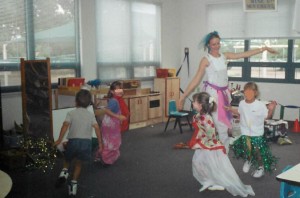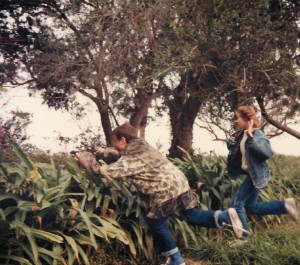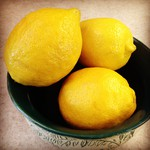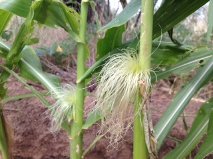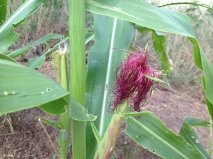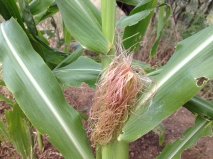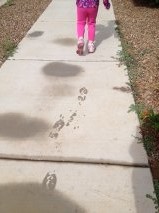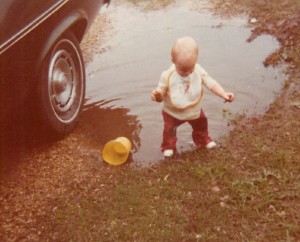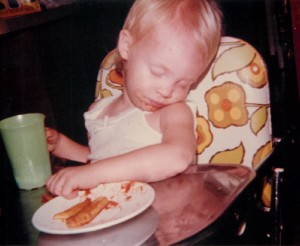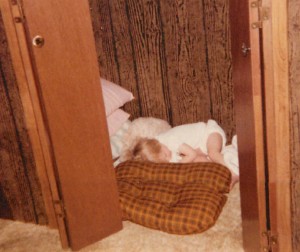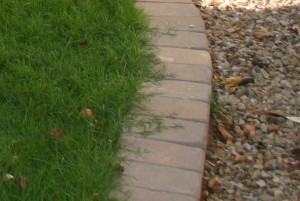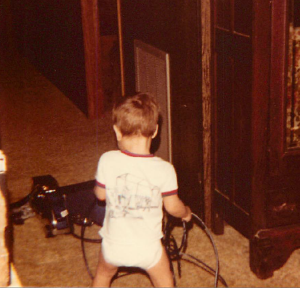 One evening, after dinner, mom told my brothers and me to clean up and wash the dishes. Of course we bickered back and forth, arguing over who would wash, rinse, dry and put away. Somehow we figured it out (my older brother probably assigned the duties). I remember watching soap being squeezed into the filling sink, bubbles rising high, and my brother taking a handful and blowing the bubbles. It looked so cool and I wanted to do it too! I believe we used up all the bubbles this way leaving a sink of warm soap clouded water, and instead of getting to work on the dishes, we made more bubbles by squeezing a huge amount of liquid soap into the already soapy water. On went the tap and a mountain of bubbles began to form again. Higher the bubbles climbed, covering the faucet, and then… the water spilled over the sink and onto the floor carrying bubbles with it. A mixture of surprise, fear and excitement froze us. The tap was turned off and we stared at the water on the floor. I stepped closer to the sink and slipped a little, catching hold of the counter to stay upright. My feet tingled and I thought, “That was fun!” Then began the slip and slide portion of the evening dishwashing. Soon, the water on the floor had spread out and it wasn’t slippery anymore. What to do…what to do? Someone had the bright idea (we are all wonderful problem solvers) to squeeze the liquid soap directly onto the damp linoleum. Yep, that worked. It’s amazing how the addition of a little extra liquid soap will turn up the volume of children’s voices to an octave parents cannot ignore. Squealing, screeching, and laughing so hard, we couldn’t catch our breaths. We glided, tumbled, and collided with the walls, the floor, each other, and the appliances. Doing the dishes was fun! Then mom walked in. I remember trying convince her of my innocence…that this was just an accident. She wasn’t buying it, but would be buying more soap because we had squeezed the container empty. There was cleaning up to do and we weren’t getting out of it, but now we had a project manager with efficiency and discipline on her mind.
One evening, after dinner, mom told my brothers and me to clean up and wash the dishes. Of course we bickered back and forth, arguing over who would wash, rinse, dry and put away. Somehow we figured it out (my older brother probably assigned the duties). I remember watching soap being squeezed into the filling sink, bubbles rising high, and my brother taking a handful and blowing the bubbles. It looked so cool and I wanted to do it too! I believe we used up all the bubbles this way leaving a sink of warm soap clouded water, and instead of getting to work on the dishes, we made more bubbles by squeezing a huge amount of liquid soap into the already soapy water. On went the tap and a mountain of bubbles began to form again. Higher the bubbles climbed, covering the faucet, and then… the water spilled over the sink and onto the floor carrying bubbles with it. A mixture of surprise, fear and excitement froze us. The tap was turned off and we stared at the water on the floor. I stepped closer to the sink and slipped a little, catching hold of the counter to stay upright. My feet tingled and I thought, “That was fun!” Then began the slip and slide portion of the evening dishwashing. Soon, the water on the floor had spread out and it wasn’t slippery anymore. What to do…what to do? Someone had the bright idea (we are all wonderful problem solvers) to squeeze the liquid soap directly onto the damp linoleum. Yep, that worked. It’s amazing how the addition of a little extra liquid soap will turn up the volume of children’s voices to an octave parents cannot ignore. Squealing, screeching, and laughing so hard, we couldn’t catch our breaths. We glided, tumbled, and collided with the walls, the floor, each other, and the appliances. Doing the dishes was fun! Then mom walked in. I remember trying convince her of my innocence…that this was just an accident. She wasn’t buying it, but would be buying more soap because we had squeezed the container empty. There was cleaning up to do and we weren’t getting out of it, but now we had a project manager with efficiency and discipline on her mind.
Young children learn skills by observing their surroundings and mimicking parents, caregivers and siblings. A toddler may reach for a parent’s phone or move a broom back and forth in an effort to mimic their parent. In the area of household chores, it is useful and healthy to involve your child. By allowing your child to participate you are not only teaching valuable skills such as math, language, problem solving and physical, but also spending one on one time with them, supporting their social emotional development. A child who spends time with their parent during chores, may associate those positive experiences with chores as they get older. This means a parent may have more cooperation with household chores as children enter adolescence, and less need to use, “Because I said so”. Children also develop responsibility skills when completing chores, and this is something your child’s teachers will thank you for later, as homework becomes a regular chore.
It’s never too early to involve your child in the household chores. With infants you may hand them a sock to hold and explore as you sort and fold the laundry. Talk to them and explain what you are doing. Toddlers and preschoolers can help sort clothes, put them into the washer or dryer, and begin to identify their clothes. You can point out size differences, colors, and textures. When your child indicates a desire to vacuum, even if they are just practicing with the vacuum off, let them try it out. The experience may pay off later, as you enjoy clean carpets vacuumed by your teen.
It is important to remember that children may not ‘get it right’ often, or may need reminders. Of course, supervision is key. I know that prior to the soap bubble extravaganza of 1983 my brothers and I had successfully done the dishes a few times. So, mom must have felt comfortable leaving us to the task…but kids will be kids, right?

